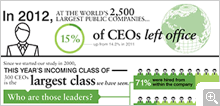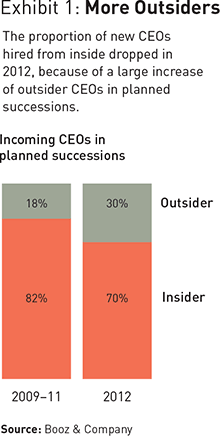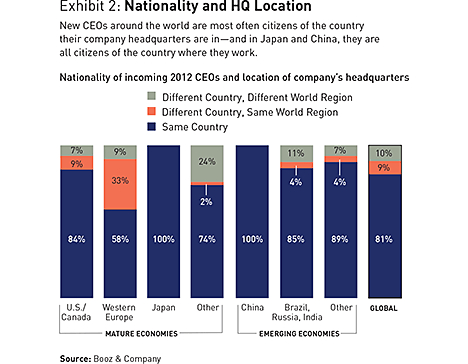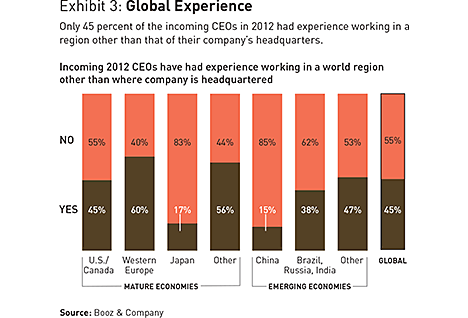Portrait of the Incoming Class
The newest CEOs have neither the diversity nor the global backgrounds that you might expect.
For the most part, they are familiar faces. The majority of them were promoted from within the company they now run. Less than half of the new chief executives have spent any time at all working outside their company’s home region. And almost all of them are middle-aged men.
This snapshot of the 2012 incoming class of chief executives puts to rest, at least for this year, the notion that the CEO candidate most likely to be hired is the one with the highest level of global diversity. The data also offers an indication of growing leadership stability at the top of large companies, and our conversations with CEOs have frequently confirmed that point of view.
The most notable characteristic of the 2012 class members is their collection of resumes. Of the 300 new CEOs at the world’s largest 2,500 companies, about 30 percent came from outside the companies that hired them. This is a significant increase (45 percent) over the level of the previous three years, for which an average of 20 percent were outsiders. Interestingly, the entire increase is attributable to companies where the transition to a new CEO was planned, not forced (see Exhibit 1). This trend toward outsiders seems a bit paradoxical in light of another finding from our study: As in the past, insider CEOs typically lead their companies to better financial returns than do outsiders.
Just because a larger portion of 2012’s class of CEOs come from outside the company, however, does not mean that they bring a different regional perspective. Fully 81 percent of incoming chief executives, both insiders and outsiders, are natives of the country in which the companies hiring them are headquartered (see Exhibit 2). As you might expect, that number varies depending on geography. For Chinese companies in 2012, all incoming CEOs came from China. For Japanese companies, they all came from Japan. For western European companies, just 58 percent of the new CEOs in 2012 came from the country where their companies are based. Another 33 percent came from another European country.
A similar geographic insularity is indicated by CEO work experience. Less than half of incoming CEOs have ever worked in regions outside where their companies are headquartered, a proportion that declines to less than 20 percent in both China and Japan (see Exhibit 3). At companies in the U.S. and Canada, the proportion of new CEOs with global experience was right at the global average, whereas western Europe had the highest proportion, at 60 percent. Given the critical importance of taking a global perspective on business in the 21st century, these numbers seem surprising. One cause may be the increasing levels of connectedness through global travel and telecommunications, which make it possible to be a global CEO without having to work around the world or live in more than one country. In addition, at the C-suite level, the common “language” of business—the mutual understanding of enterprise strategy and management—is always prevalent, fostering communication even when executives speak different languages.
The way that companies bring their new CEOs on board has changed significantly over the years. In 2012, 29 percent of the companies in a planned chief executive transition followed an apprenticeship model, a model in which the outgoing CEO remains or becomes chairman and thus can help “apprentice” the incoming CEO. Of the companies that chose this model, 85 percent chose an insider as CEO, far higher than the number that chose outsiders. The data suggests that these companies are seeking continuity through their chief executive transition.
The variation among companies from different regions choosing the apprenticeship model is noteworthy. In Japan, in keeping with the country’s tight-knit ways, and where 80 percent of turnover events in 2012 were planned, 69 percent of new CEOs saw their predecessor stay on as chairman. By comparison, just 15 percent of new CEOs at companies in Europe were mentored by the previous CEO.
By the same token, the percentage of companies appointing their new leader as both chairman and chief executive stood as high as 48 percent 10 years ago. Since then, however, the proportion has declined significantly, leveling off at around 12 percent since 2009. As we have observed in past studies, the willingness to concentrate power at the top appears to be more prevalent in North America. Fully 20 percent of new CEOs at companies in North America were also appointed chairman in 2012, a significantly higher proportion than in any other region. In Japan, by contrast, no new CEO also held the chairmanship.
How Leaders Lead
Despite their widely varying backgrounds, nationalities, and career paths, virtually all new chief executives we have spoken to over the years agree on one thing: This job is different from all other executive posts. The sense of responsibility increases by an order of magnitude, and the decisions carry much more weight. Preparation is key, but not every new CEO is given that luxury. In any case, whether or not the succession is planned, the new CEOs must lead—moving quickly to gather together the best team possible, making clear to all stakeholders his or her vision for the company’s future, and serving as a model for how he or she expects everyone to behave. ![]()
Reprint No. 00184
Author profiles:
- Ken Favaro is a senior partner with Booz & Company based in New York. He leads the firm’s work in enterprise strategy and finance.
- Per-Ola Karlsson is a senior partner with Booz & Company based in Stockholm. He serves clients across Europe and the Middle East on issues related to organization, change, and leadership.
- Gary L. Neilson is a senior partner with Booz & Company based in Chicago. He focuses on operating models and organizational transformation.
- Also contributing to this article were Booz & Company senior manager Josselyn Simpson and specialist Jane Kim, and s+b contributing editor Edward H. Baker.








